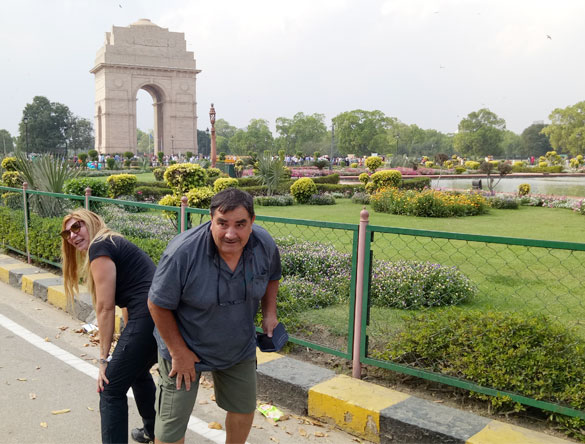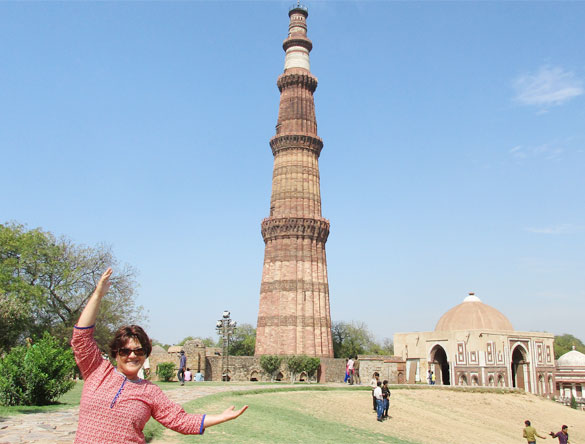DAY 01
Delhi Arrival
Our representative and driver will meet you on arrival at the airport and you will be transferred to your hotel. Check into the hotel.
DELHI, the capital of kingdoms and empires is now a sprawling metropolis with a fascinating blend of the past and the present. Delhi is a perfect introduction to the composite culture of an ancient land and a window to the kaleidoscope - that is India.
Overnight will be at Delhi.
DAY 02
Delhi
Enjoy a guided tour of Old Delhi after breakfast.
The tour will begin with a visit to Raj Ghat, a simple memorial to Mahatma Gandhi. He is also famously known as the “father of the nation”.
One of the most important buildings of Old Delhi is the RED FORT. The magnificent Red Fort was built during the years 1638 – 48 when the Mughal Empire was at its peak. In 1638 Shahjahan transferred his capital from Agra to Delhi and laid the foundations of Shahjahanabad, the seventh city of Delhi. It is enclosed by a rubble stonewall, with bastions, gates and wickets at intervals. Of its fourteen gates, the important ones are the Mori, Lahauri, Ajmeri, Turkman, Kashmiri and Delhi gates, some of which have already been demolished. His famous citadel, the Lal-Qila, or the Red Fort, lying at the town's northern end on the right bank or the Yamuna and south of Salim Garh, was begun in 1639 and completed after nine years. The Red Fort is different from the Agra fort and is better planned, because at its back lies the experience gained by Shahjahan at Agra, and because it was the work of one hand. It is an irregular octagon, with two long sides on the east and west, and with two main gates, one on the west and the other on the south, called Lahauri and Delhi gates respectively. While the walls, gates and a few other structures in the fort are constructed of red sandstone, marble has been largely used in the palaces.
Continue your tour to Jama Masjid by bicycle rickshaws, one of Asia’s largest mosques. People stream in and out of the mosque continuously and the presence of a nearby bazaar means that the area is rarely quiet.
Enjoy the rickshaw ride at Old Delhi peddling through the narrow by lanes of Chandani Chowk.
After lunch proceed for a sightseeing tour of New Delhi, which reflects the legacy of the British left behind. The division between New and Old Delhi is the division between the capitals of the British and the Mughals respectively. The division in the walled city and New Delhi also marks the division in the life-styles. The walled city is all tradition where one will be able to glean a past life-style in all its facets, colors and spells. New Delhi in contrast, is a city trying to live up to the best of 21st century standards.
Imperial Delhi will include the Qutub Minar, the tallest stone tower in India. Qutub-Minar in red and buff stand stone is the highest tower in India. It has a diameter of 14.32 m at the base and about 2.75 m on the top with a height of 72.5 m. Qutbu'd-Din Aibak laid the foundation of Minar in AD 1199 for the use of the mu'azzin (crier) to give calls for prayer and raised the first floor, to which were added three more floors by his successor and son-in-law, Shamsu'd-Din Iltutmish (AD 1211-36). All the storeys are surrounded by a projected balcony encircling the Minar and supported by stone brackets, which are decorated with honeycomb design, more conspicuously in the first floor.
Next stop would be the majestic Humanyun’s Tomb. Humayun died in 1556, and his widow Hamida Banu Begum, also known as Haji Begum, commenced the construction of his tomb in 1569, fourteen years after his death. It is the first distinct example of proper Mughal style, which was inspired by Persian architecture. It is well known that Humayun picked up the principles of Persian architecture during his exile, and he himself is likely to have planned the tomb, although there is no record to that effect.
The tour also includes a drive past the imposing India Gate, the Parliament building and the Rashtrapati Bhawan, the President’s residence.
Overnight will be at Delhi.
DAY 03
Delhi – Leh by Morning Flight
On arrival at Leh airport, our representative will transfer you to the hotel. Have breakfast in the hotel and rest the whole day for acclimatization.
Leh is a beautiful Himalayan destination in Ladakh, North India. It’s a dream destination of almost every biker. Leh is the second largest district in the country. Its elevation is approximately 3555 meters (11,490 feet). Leh is a small town, easy to get most places by foot. The old town is a compact area of mud brick houses and narrow lanes directly to the east of Main Bazar. Changspa is the agricultural "suburb" northwest of the center, with many guesthouses. Leh is in the abode of the rocky paradise of Ladakh. Ladakh is one of the fascinating spots on the face of the earth and the beauty of the region is unbelievingly marvelous. Leh is a treasure of rich culture and natural resources as well as a heaven for adventure enthusiasts.
In the evening go for leisurely strolls to the market.
Overnight will be in Leh.
DAY 04
Leh – Pangong Tso
Have breakfast and precede to Pangong Tso, visiting the third highest pass in the world the Changla Pass enroute.
Pangong Lake or Pangong Tso (Tso: Ladakhi for lake) is a high altitude brackish/salt water lake situated in the Himalaya at a height of about 4,350 m (13,900 ft). A third of the lake lies in India while two thirds of the lake lies in China. The lake is supposedly 5 km wide at its broadest point.
Pangong Tso is about five hours drive from Leh, most of it through spectacular valleys. The road also traverses the Changla pass, where army sentries and a small teahouse greet visitors. The Tea is FREE.
A special permit is required to visit the lake.
Stay overnight in a nice camp adjacent to the Pangong Lake.
DAY 05
Pangong Tso - Leh
Have breakfast and drive back to Leh. Enroute see Hemis & Thiksey monasteries as well as Stok Palace.
Thiksey Monastery: About 20 Kms from Leh, Thiksey is an imposing monastery and one of the finest examples of Ladakhi architecture. This Gompa is situated on the top of the hill and forms part of Gelukpa order. Paldan Sherab nephew of Sherb Zangpo founded Thiksey monastery. The 12 storey monastery complex contains numerous stupas, statues; thankas, wall paintings, swords and a large pillar engraved with the Buddha's teachings, there are sacred shrines and a many precious objects to be seen. The successive reincarnation of the Skyabje Khampo Ringpoche, act as in charge of the monastery. Thiksey gustor (festival) held from 17th to 19th day of the 12th month. The main prayer hall has a 15 meter high seated Buddha figure. There are chance to see prayer in the early morning.
Hemis Monastery: the largest monastery in Ladakh was built in 1630. It belongs to the red sect, Brokpa. It lies at a distance of 45 km south of Leh. Impressive and intriguing, Hemis is different from the other important monasteries of Ladakh. The annual festival, commemorating the birth anniversary of Guru Padmasambhava, is held for two days in June-July, enlivening the courtyard of the monastery. The festival of dances, where good triumphs over evil in a colorful pageant, is also the annual 'bazaar' where Ladakhis from remote areas buy and sell wares.
Stok Monastery or Stok Gompa or Palace: It is a Buddhist monastery in Leh district, Ladakh, northern India, 15 Kms south of Leh. It was founded by Lama Lhawang Lotus in the 14th Century and has a notable library including all 108 volumes of the Kangjur. A ritual dance-mask festival is held annually. It was used for some time as a residence by the Ladakhi royalty.
Overnight will be in Leh.
DAY 06
Leh
Have a relaxed breakfast. Today you will explore Leh.
Visit the following places:
Hall of Fame museum: Hall of Fame near Leh is worth a visit for every citizen. It is a glorious museum constructed by Indian army. You can see the memorabilia, eminent defense personalities with biographies, images and weapons used during Kargil war and belongings of enemy soldiers found at war site. Another section of this building is entirely dedicated to Siachen and its heroes. On display are attires, multi layered shoes to keep their feet from frost bites, their daily instruments, their day to day food mainly frozen and packed, which is heated by lighting small balls of Hexamycin tablets, as fire is difficult to ignite at a temperature dipping -30 deg to -50 deg centigrade. It is mentioned on a board that 97% of the casualties in Siachen are due to cold and terrain.
Shanti Stupa: Japanese Stupas made for world peace. Shanti Stupa is located at Changspa, on the hilltop, and was inaugurated by Dalai Lama in 1985. Its state of the art work attracts a lot of tourists to Ladakh and is spectacular to watch. The Shanti Stupa can be reached by car, or on foot via a steep flight of five hundred steps.
You will enjoy the panoramic view of the chain of mountains and the peaceful little village of Changspa with typical Ladakhi houses built along a gushing stream, and the towering Namgyal Tsemo in the distance.
In the evening you can visit the local markets.
Overnight will be in Leh.
DAY 07 - 08
Leh to Nubra Valley (5600 M)
Have breakfast and proceed to Nubra Valley.
The trip takes you across the Ladakh Range over Khardung La (5600 m), which is reputed to be the highest motorable road in the world! The main features of the Nubra Valley are its deep sheer-sided valleys flanked by the towering peaks of the Ladakh Range to the south and the Karakorum Range to the north.
Double-humped Bactrian camels can sometimes be seen. These were used as pack animals on the ancient trade route between Leh and Yarkand.
Stay overnight in a camp.
DAY 09
Nubra Valley - Leh
Have breakfast and drive back to Leh.
Spend a leisurely afternoon & evening at Leh.
Overnight will be in Leh.
DAY 10
Leh – Shergol
Have breakfast and proceed for Shergol. Enroute see the confluence of Zanskar & Indus Rivers.
Also experience the following:
Magnetic hill: Defying the Law of gravity. This place is close to the Gurdwara Shri Patthar Sahib. It has been noticed that when a vehicle is parked on neutral gear on this metallic road the vehicle slides up.
Gurdwara Patthar Sahib: The Shrine known as Gurdwara Patthar sahib is situated about 25 kms. Short of Leh town on the Leh-Srinagar road. Built in the everlasting memory of Shri Guru Nanak Dev, the great prophet who sanctified the place by his sacred visit during the year 1517 while on his second missionary tour. The Guru reached here via Nepal, Sikkim, Tibet, Yarkand and Leh after having spiritual discourses with the Sidhas at Mount Sumer (Central Himalayas).
Lamayuru Monastery: Lamayuru monastery is the oldest and one of the largest monasteries in Ladakh region.
Alchi Monastery: Alchi Gompa is a Buddhist monastery, known more as a monastic complex (chos-'khor) of temples in Alchi village in the Leh District.
Likir Monastery: Likir is mentioned in the Ladakhi chronicles as having been erected by King Lhachen Gyalpo (Lha-chen-rgyal-po) (c. 1050-1080 CE). The name Likir means "The Naga - Encircled", representing the bodies of the two great serpent spirits, the Naga-rajas, Nanda and Taksako. It presumably, originally belonged to the early Kadampa order of Tibetan Buddhism.
Reach Shergol and stay at Nunkun camp, which is about 30 kms before Kargil. Kargil has very basic accommodation and we would therefore recommend this camp with attached toilets.
Overnight will be in Shergol.
DAY 11
Shergol - Srinagar
Have breakfast and proceed for Srinagar via Kargil.
The capital of Jammu and Kashmir and the largest city in the state, Srinagar is famous for its canals, houseboats and Mughal gardens. The city itself is quite unlike most other large Indian cities for here you are much more in Central Asia than on the sub-continent. It's a city full of intriguing alleyways and curious buildings. A place where it's very easy to spend a few hours simply wandering - particularly along the old city streets near the Jhelum river. The city has long been a center of art and leaning. Srinagar is a unique city because of its lakes - the Dal, Nagin and Anchar. The River Jhelum also flows through a part of the city.
Enroute you can stop at Kargil: A quite town now, Kargil once served as important trade and transit centre in the Pan-Asian trade network. Numerous caravans carrying exotic merchandise comprising silk, brocade, carpets, felts, tea, poppy, ivory etc. transited in the town on their way to and from China, Tibet, Yarkand and Kashmir. Now, travelers of numerous nationalities have replaced traders of the past and Kargil has regained its importance as a centre of travel-related activities.
Visit Dras: Dras is a town in the Kargil District. It is often called 'The Gateway to Ladakh'. The town shot into prominence in the summer of 1999 following Pakistani-backed incursions into Jammu and Kashmir.
Reach Srinagar and check in houseboat.
Dal Lake has rightfully become an icon of Kashmir. A Himalayan urban lake, it has five basins and a number of channels that are well linked with each other. There are plenty of fishes in Dal Lake and fishery is the second largest industry of the region centered on the lake. The sparkling quiet waters of Dal surrounded by snow-capped mountains on its three sides undoubtedly mark it as one of the most beautiful lakes of India.
Overnight will be in Srinagar.
DAY 12
Srinagar – Delhi by Flight
Delhi – Agra – Delhi by Road
Breakfast in the boat.
Fly to Delhi and then drive to Agra.
AGRA: Two great Mughal monarchs, Akbar and Shah Jahan, transformed the little village of Agra into a befitting second capital of the Mughal Empire – giving it the name Dar-ul-Khilafat {seat of the Emperor}. Today a visitor to Agra is caught up in a world of contrasting edifices, of red sandstone and white marble, narrow galleys and quaint buggies, and that irresistible charm that this favorite city of the Mughals still retains. It is not surprising, that modern Agra still reflects its Mughal heritage most conspicuously. A walk down the narrow bustling streets of the city will introduce the visitor to the wafting aroma of Mughlai cuisine.
TAJ MAHAL (Fridays closed): Little needs to be said about this architectural wonder, which is always the soul raison-de-etre for every tourist's visit to Agra. Built by Shah Jahan, the Taj is a white marble memorial to his beautiful wife Mumtaz Mahal. This monument took 22 years to be completed and was designed, and planned by Persian architect Ustad Isa. Apart from its stunning design balance and perfect symmetry, the Taj is also noted particularly for its elegant domes, intricately carved screens and some of the best inlay work ever seen.
As per the timing you will be driven to the international airport in Delhi to take a flight back home with sweet memories of the tour.
TOUR ENDS.
-


